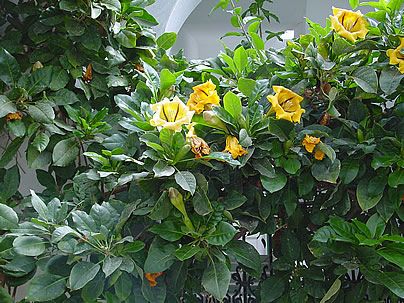The Golden Chalice Vine (Solandra maxima) is a sprawling and climbing shrub, flower-bearing and native to Central America, South America, and Mexico. It’s an ornamental plant that stands out mainly for its huge, chalice-shaped flowers in a beautiful ocher yellow hue. It produces long, thick, flexible branches, erect to sprawling, woody, which can reach up to 60 meters (197 feet) in length, with branching and adventitious roots from the nodes. Its leaves are elliptical, leathery, very shiny, dark green in color.
It blooms sparsely throughout the year, and more intensely in the fall and winter or in the driest season. Initially, it sprouts large inflated buds, which resemble air balloons. As they open, the flowers reveal the corolla, fused at its base, thus forming a wide open cup, with wine-colored rays and long stamens. On the edges, the five petals separate and curl outward.
The flowers are cream yellow in color when they open and, as they mature, acquire a strong ocher tone. The flowers tend to be more fragrant at night, with an aroma reminiscent of ripe banana to coconut, and attract bats, their pollinators. It rarely fruits in cultivation, producing berry-type fruits, round, fleshy, and non-edible.

Despite its exuberant flowering, the Golden Chalice Vine also presents quite decorative and dense foliage. It likes a lot of space and can be used to crown walls, on fences, porticos, trellises, among other structures, as long as they are robust and reinforced, as it is a woody and leafy climber, which can reach a large size. It is also used in arbors and pergolas with the aim of providing cool shade.
Despite its vocation for climbing, it is perfectly possible to maintain it as a shrub. Regular pruning and staking may be necessary to control and guide its growth. Use gloves when pruning this plant, as the sap that exudes from cut branches causes skin and mucous membrane irritation. It allows planting in large pots and planters, to adorn balconies, terraces, sun-drenched patios, and decks.
It should be cultivated under full sun, in fertile, drainable soil, enriched with organic matter, and watered regularly. It tolerates a bit of partial shade, but this may lead to a reduction in flowering. Plant in a location protected from strong winds, which can cause burns on the leaves. Water abundantly in spring and summer, and reduce watering in autumn and winter.
Once well established, it becomes resistant to short periods of drought. Excess water in winter reduces flowering. It is resistant to cold and light frosts, however, temperatures below -3°C (26.6°F) will cause falling and burning of leaves and flowers. Fertilize monthly, using fertilizers suitable for the vegetative growth phase in spring and summer (NPK 10.10.10) and suitable for flowering in autumn and winter (NPK 04.14.08). Resistant to the salinity of coastal regions. The Golden Chalice Vine can be easily propagated by cutting semi-woody branches and air layering, preferably rooted in spring.


